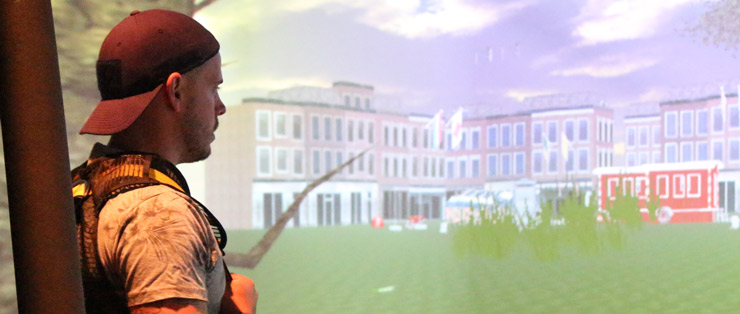
Thanks to his physiotherapist and virtual reality therapy, Canadian Forces combat engineer Daniel Schultheis is learning to adapt to chronic pain in his leg.
Canadian Forces combat engineer Daniel Schultheis was reaching for a soccer ball during a tournament at the Petawawa army base when his right knee collapsed.
“I felt the pop,” said Schultheis. “And from that point on I was in pain, and the pain hasn’t gone away.”
A specialist told the 27-year-old that the knee ligament he’d torn would heal. However, he couldn’t explain the constant pain running from knee to toe. About a year later, in January 2016, Schultheis was diagnosed with Complex Regional Pain Syndrome, a chronic pain condition that can affect nerves after an injury.
Since his diagnosis, Schultheis has travelled to The Ottawa Hospital twice a week for physiotherapy at the Rehabilitation Virtual Reality Lab. The first time Schultheis strapped on the harness and stood in front of the curved screen, he didn’t know what to expect.
“I was very interested from the beginning to see what it was,” said Schultheis. “I had no idea that we even had tools like this for physiotherapy.” The projected 3D world and force-sensing treadmill helped Schultheis work on his balance and mobility in a safe environment.
“Virtual reality allows a physiotherapist who treats CRPS to address the changes in the nervous system in a controlled manner that is specific to that patient,” said Janet Holly, Schultheis’ physiotherapist.
Once the system was calibrated to his condition, Holly and the staff member operating the system gave Schultheis small doses of therapy using different games and scenarios.
“They’ve been absolutely incredible; I can’t put into words how much they’ve helped me,” said Schultheis. “They’re some of the few people who have a true understanding of what I’m dealing with, which is rare because it’s an invisible condition. They’ve helped me learn so much about myself, how to read my body and how to adapt my day-to-day life.”
Some of those adaptations include coaching soccer on the base instead of playing it, and waking up at 5:30 a.m. so he can work out his upper body at a time when his pain levels are at their lowest.
The Rehabilitation Virtual Reality Lab is only one of the treatments used by physiotherapists, who have the skills to identify which patients will benefit from it. The lab was made possible through financial support from The Ottawa Hospital, Canadian Forces Health Services, the community and The Ottawa Hospital Foundation.

Support patient care and research at
The Ottawa Hospital


 To reset, hold the Ctrl key, then press 0.
To reset, hold the Ctrl key, then press 0.
Comment on this post